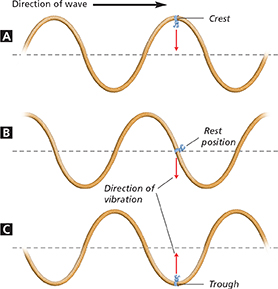Types of Mechanical Waves
Mechanical waves are classified by the way they move through a medium.  The three main types of mechanical waves are transverse waves, longitudinal waves, and surface waves.
The three main types of mechanical waves are transverse waves, longitudinal waves, and surface waves.
Transverse Waves
When you shake one end of a rope up and down, the vibration causes a wave. Figure 2 shows a wave in a rope at three points in time. Before the wave starts, every point on the rope is in its rest position, represented by the dashed line. The highest point of the wave above the rest position is the crest. The lowest point below the rest position is the trough (TRAWF). You can see from the ribbon attached to the rope that crests and troughs are not fixed points on a wave. In Figure 2A, the ribbon is at a crest. In Figure 2C, the ribbon is at a trough. The motion of a single point on the rope is like the motion of a yo-yo. The point vibrates up and down between a maximum and minimum height.
Notice that the wave carries energy from left to right, in a direction perpendicular to the up-and-down motion of the rope. This is a transverse wave. A transverse wave is a wave that causes the medium to vibrate at right angles to the direction in which the wave travels.
Have you ever shaken crumbs off a picnic blanket? This is another example of a transverse wave. Shaking one end of the blanket up and down sends a transverse wave through the blanket. The up and down motion of the blanket helps to shake off the crumbs.
Figure 2 A transverse wave causes the medium to vibrate in a direction perpendicular to the direction in which the wave travels. In the wave shown here, each point on the rope vibrates up and down between a maximum and minimum height. A The ribbon is at a crest. B The ribbon is at the rest position. C The ribbon is at a trough.
Comparing and Contrasting How does the direction of the wave compare with the direction in which the ribbon moves?
 d
d




